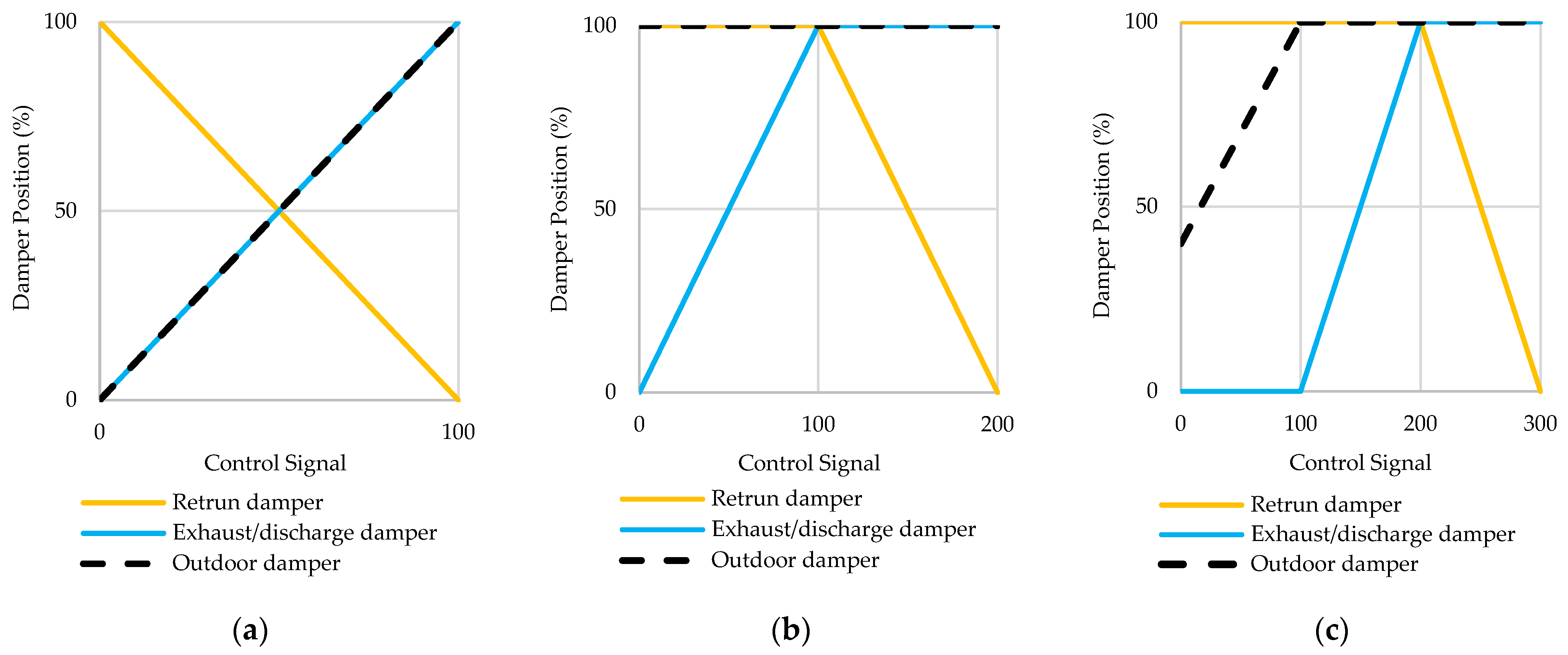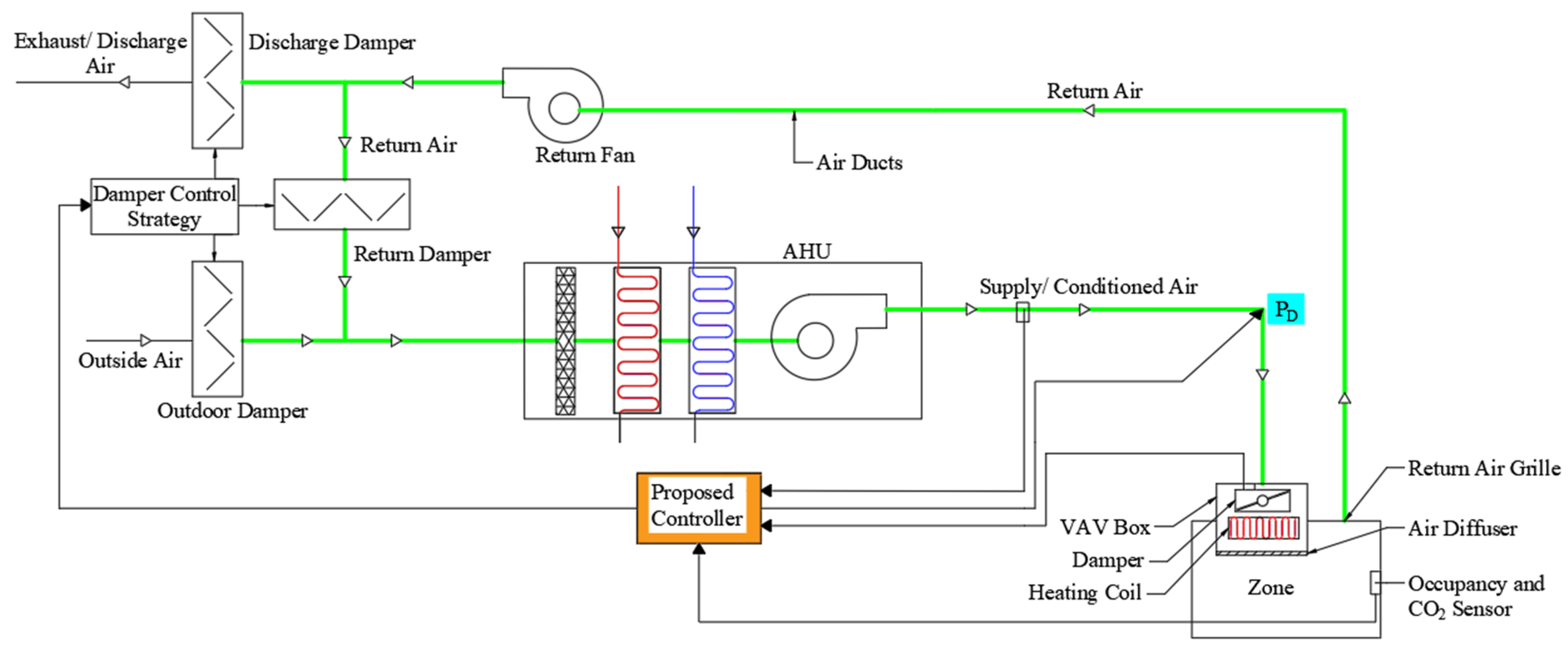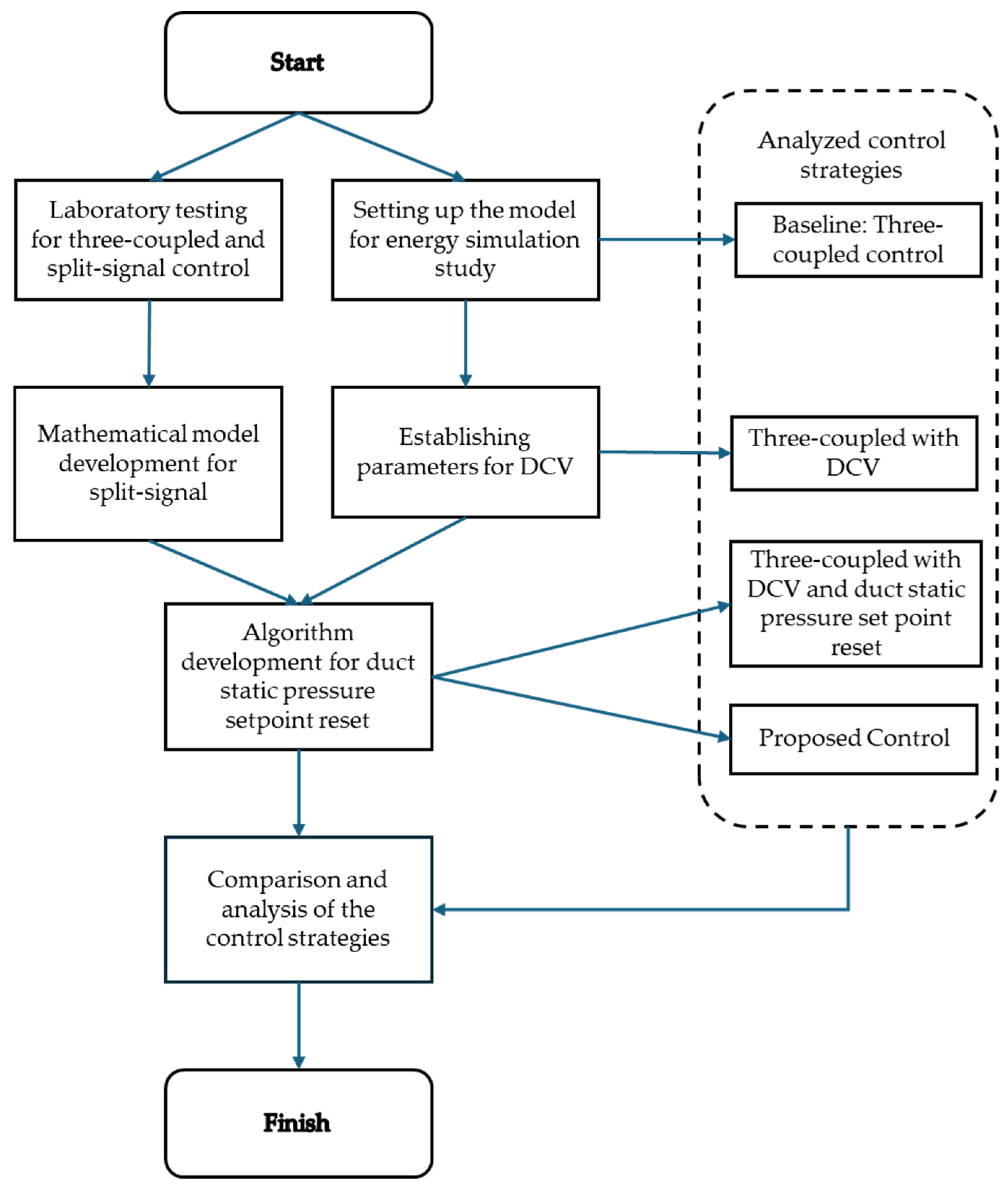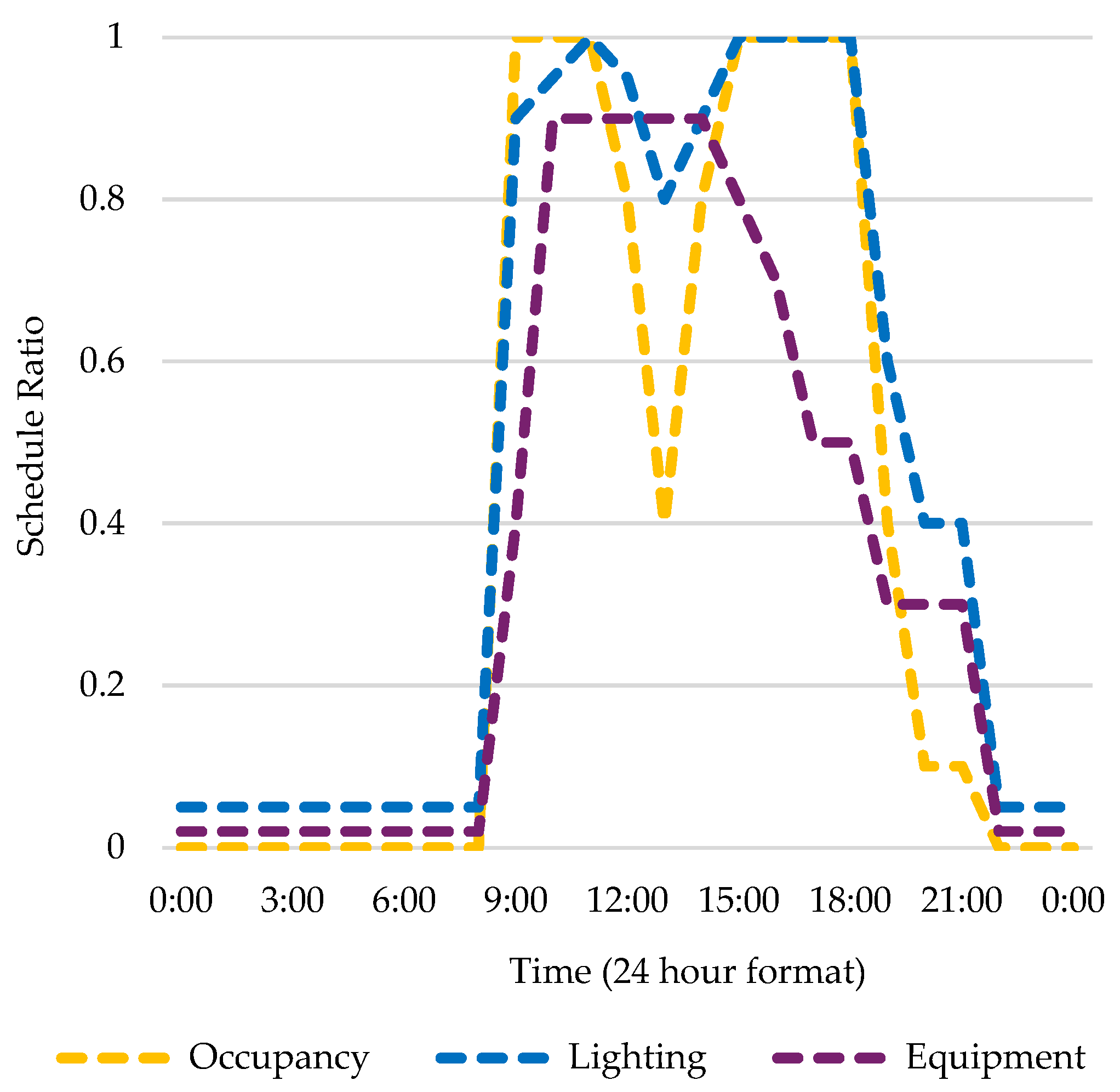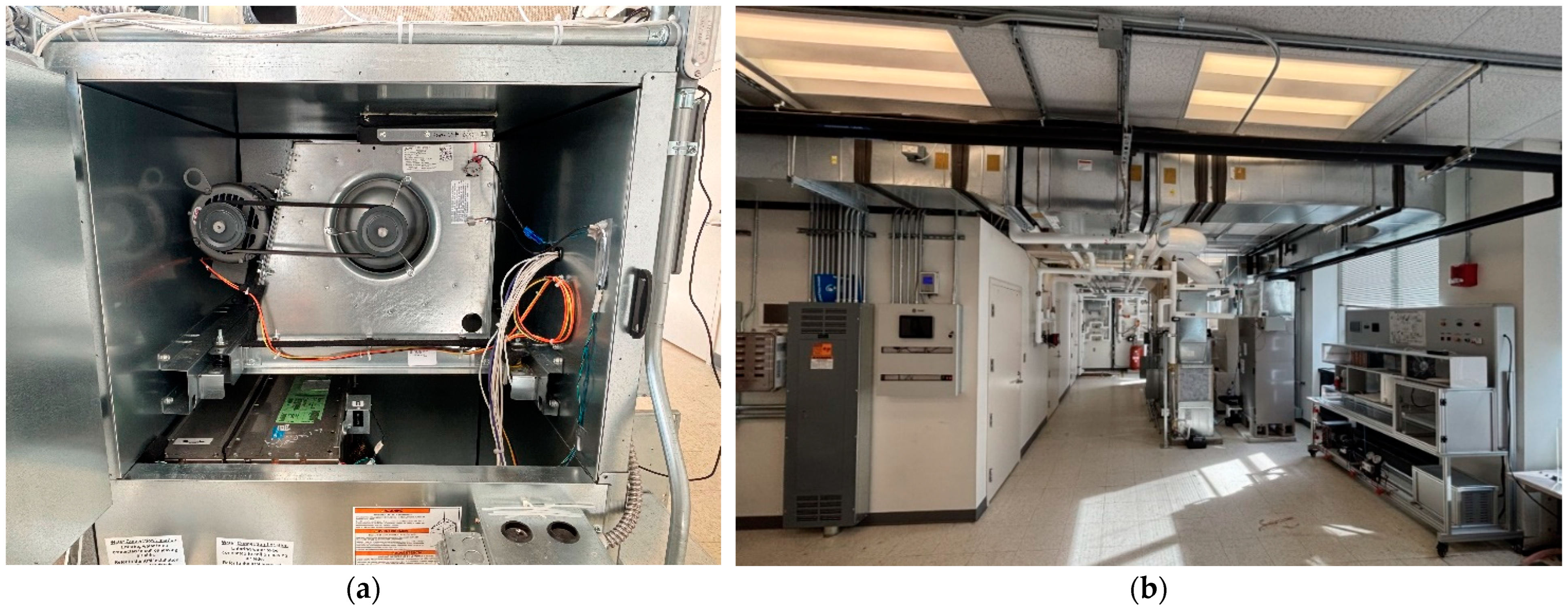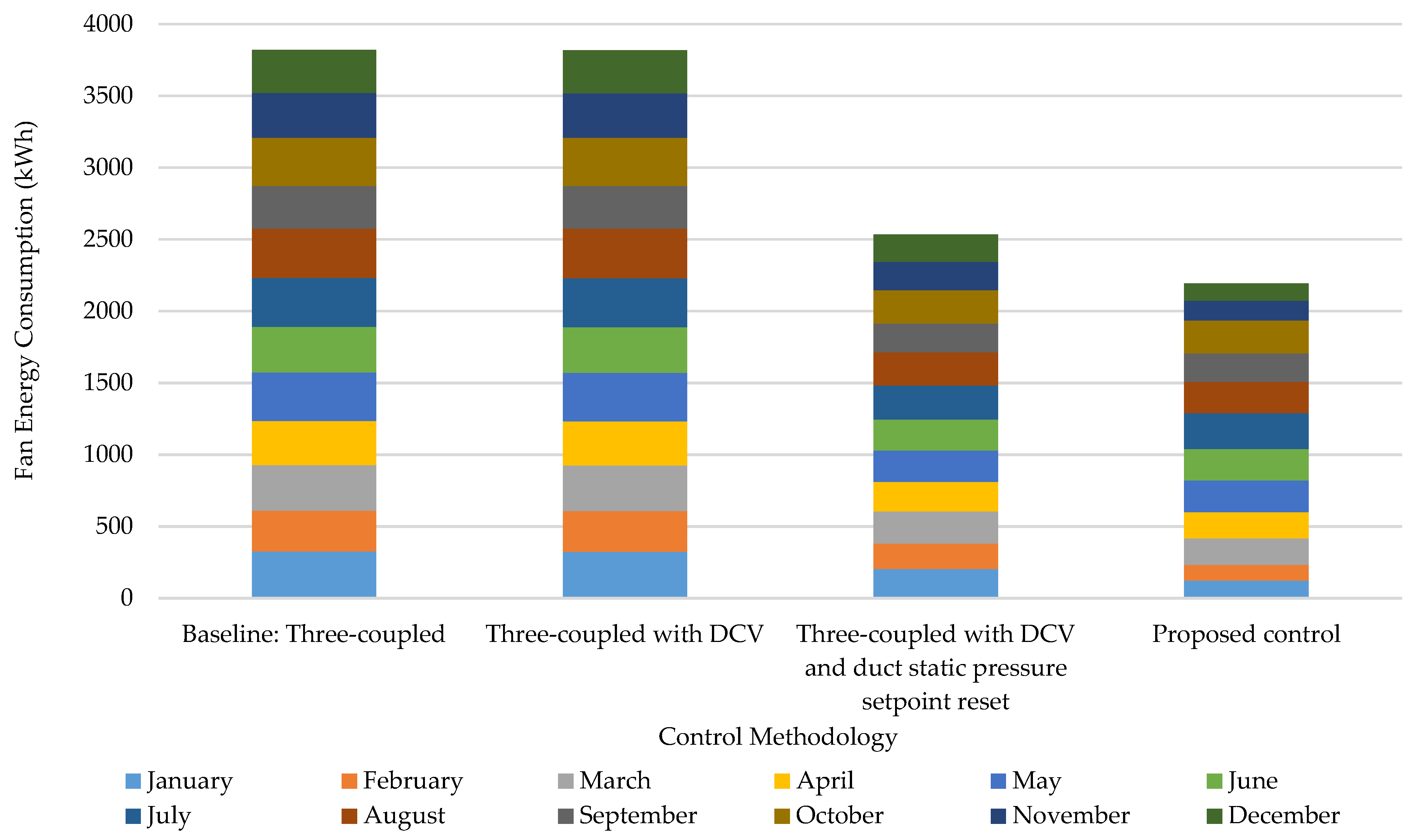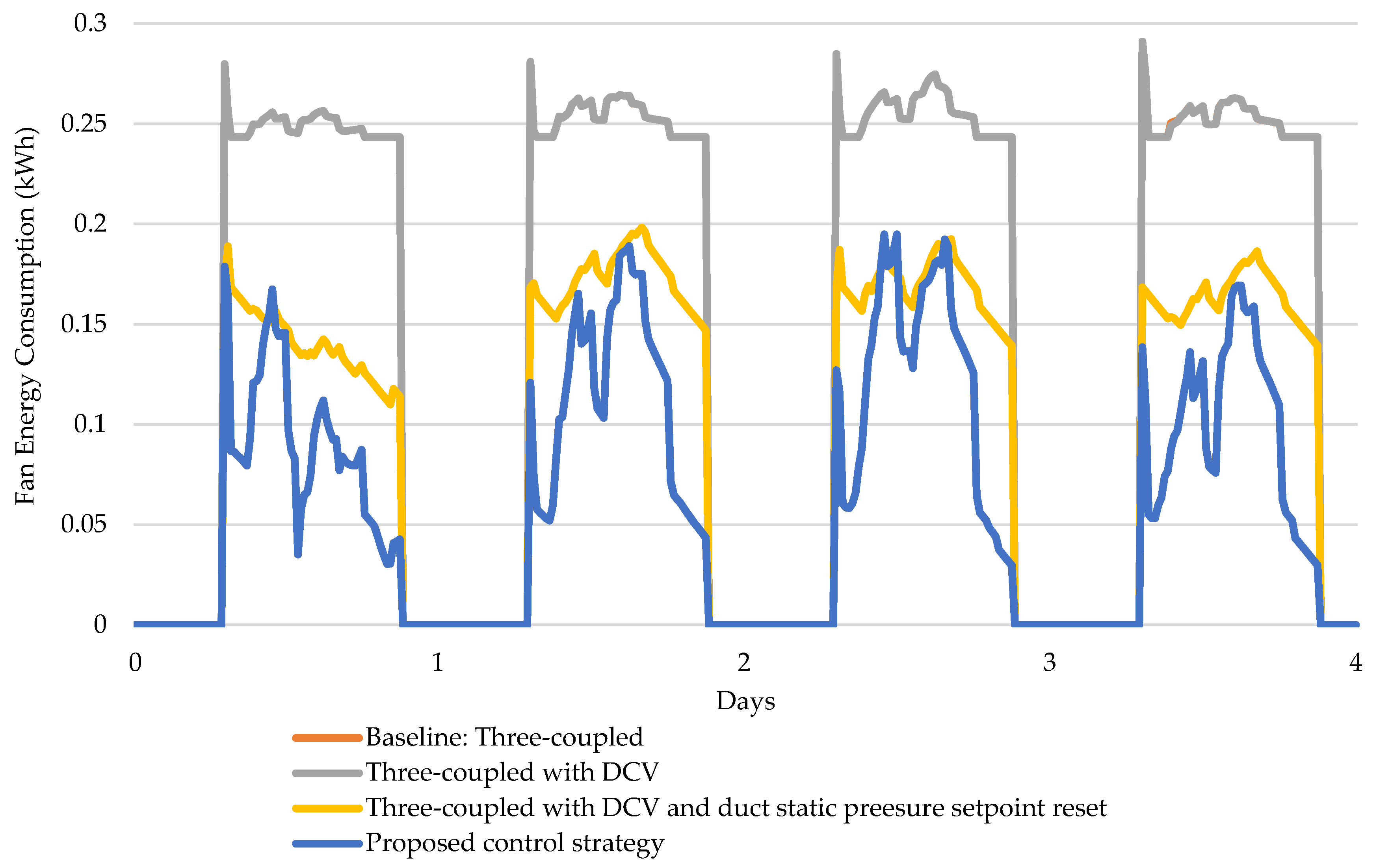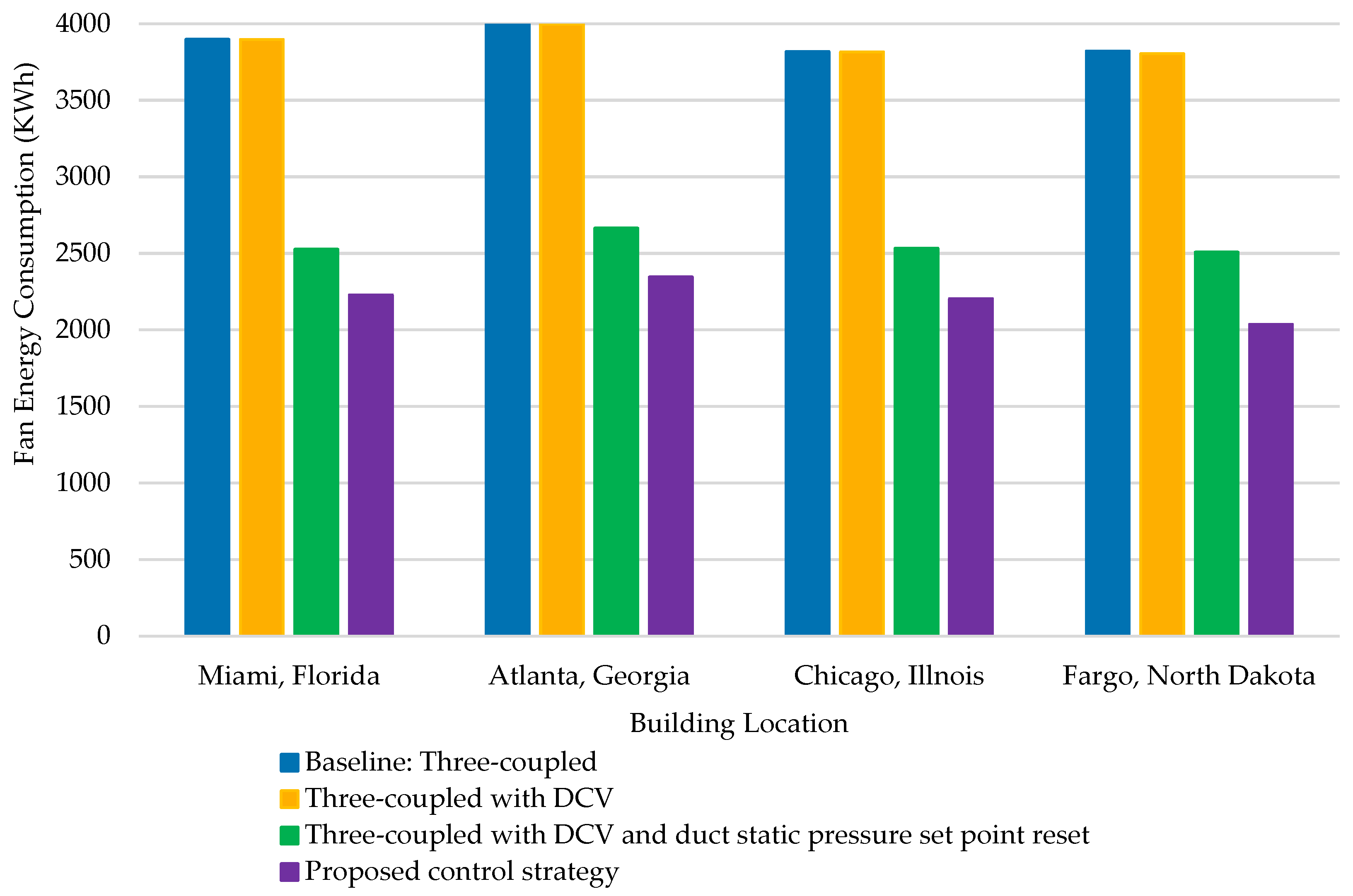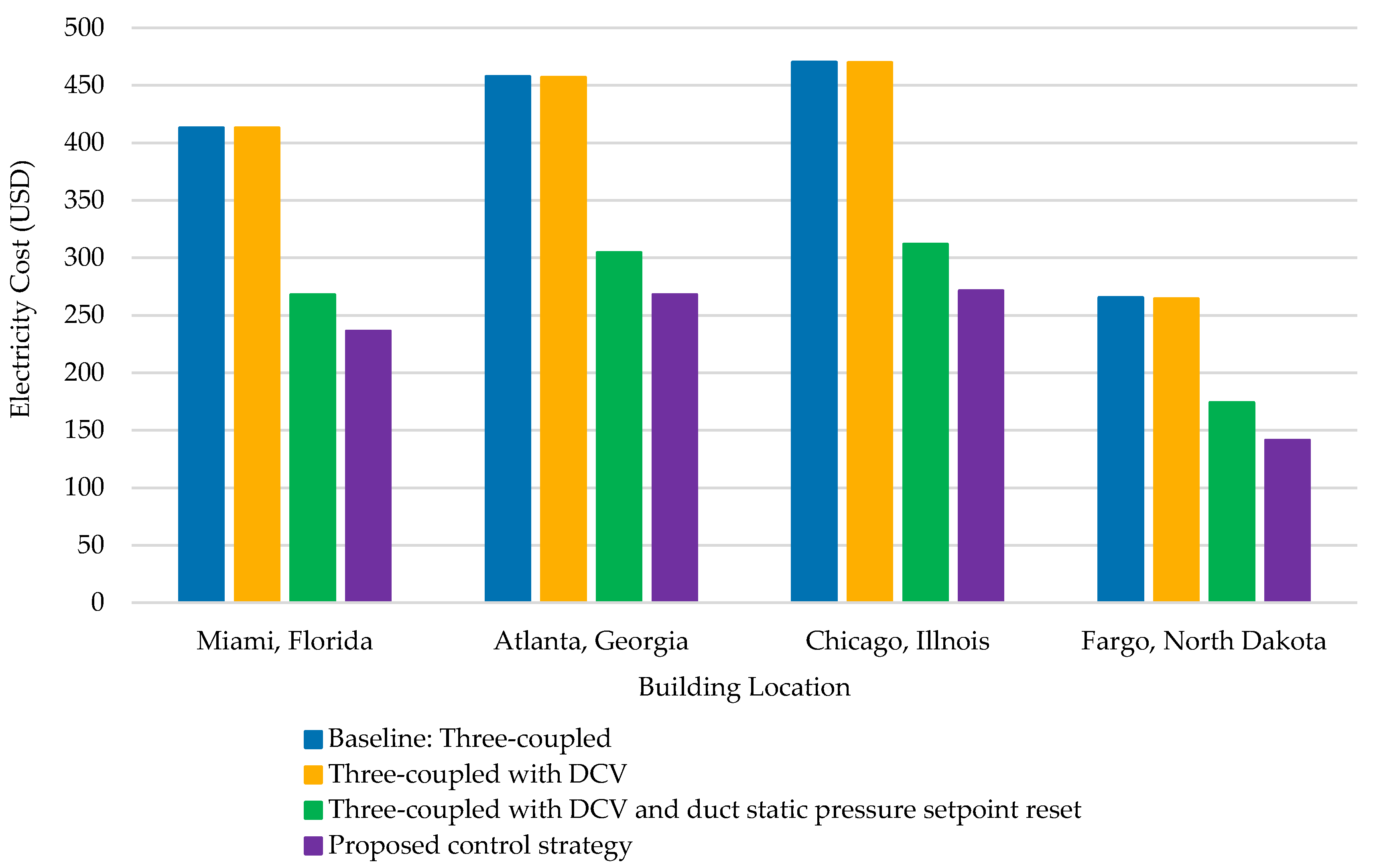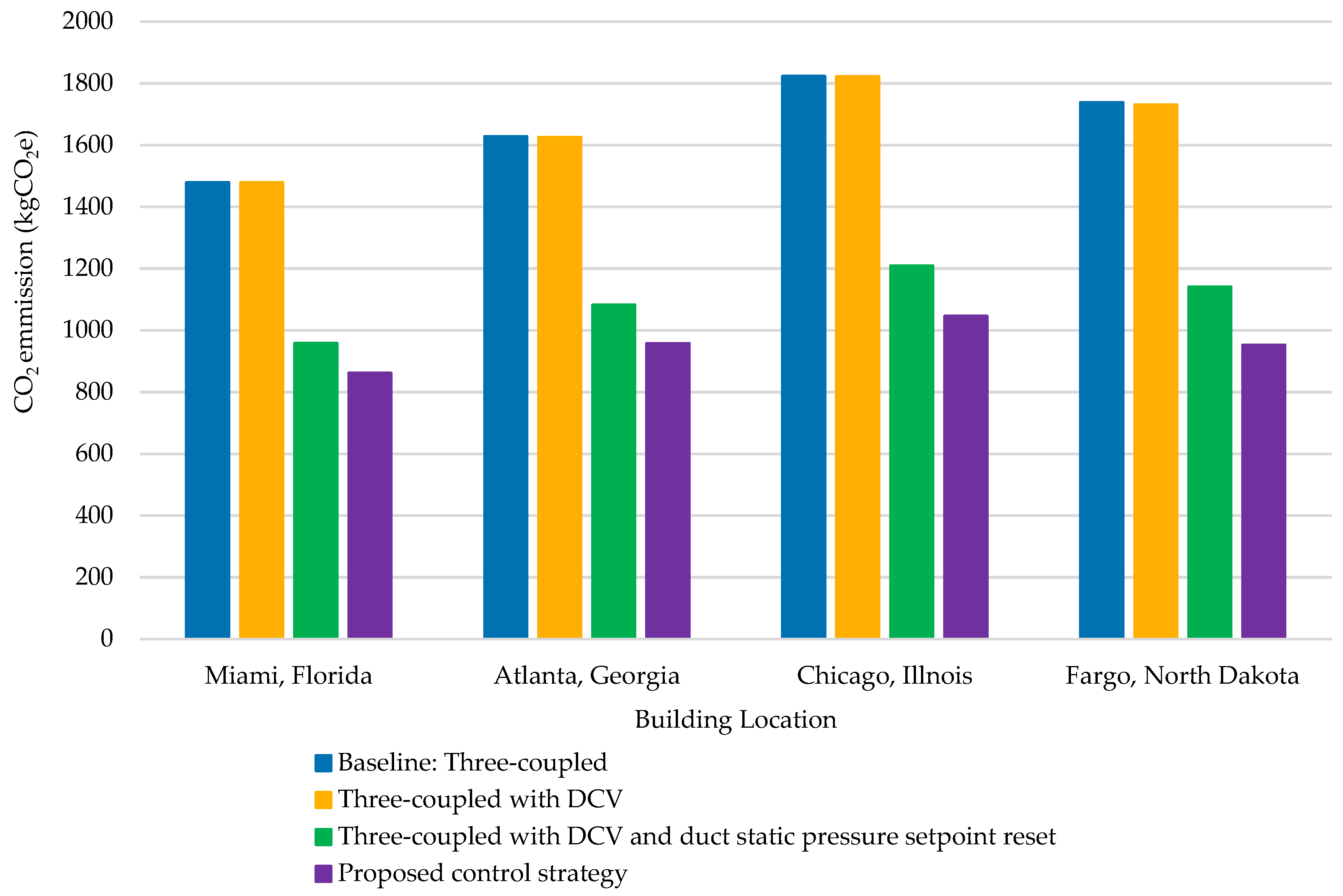1. Global Energy Consumption Trends and Strategies for Optimization
1.1. Operational Energy Requirements of Commercial Buildings
Buildings have emerged as the largest energy consumers in the world [
1], accounting for over one-third of total final energy consumption [
2], a trend that continues to rise with increasing urbanization. Heating, ventilation, and air conditioning (HVAC) systems are the primary contributors to energy consumption [
3] and use more than 50% of the energy used in commercial buildings [
4]. The high energy demand of these systems, which are indispensable in maintaining indoor thermal comfort, is becoming unsustainable as it contributes to rising energy costs and environmental degradation. As the global population is projected to increase, the energy burden on HVAC systems is expected to triple by 2050 [
5].
Addressing these challenges is critical not only to reduce operational costs but also to combat the environmental impact associated with excessive energy use. The urgency to develop innovative and sustainable solutions to curb energy consumption in commercial buildings is greater than ever, ensuring a balance between comfort, efficiency, and environmental sustainability. As efforts to reduce HVAC energy consumption progress, it is equally important to maintain optimal indoor environmental conditions for occupant health and well-being [
6]. One promising strategy is the implementation of occupancy-based HVAC controls, such as demand-controlled ventilation, also known as DCV [
7].
1.2. Role of DCV
In conventional HVAC systems, outdoor airflow rates are typically set to facilitate maximum occupancy, regardless of actual space usage. This often results in an excess supply of fresh air, leading to significant energy waste. DCV systems provide a more efficient alternative by adjusting ventilation rates dynamically and responding to real-time occupancy and indoor air quality [
8]. These systems monitor key factors, such as CO
2 concentrations and volatile organic compounds (VOCs), etc., while utilizing occupancy sensors to track actual space usage. This approach can lead to substantial energy savings by conditioning only the necessary amount of fresh air.
For example, Chao and Hu [
9] introduced a dual-mode DCV strategy designed for commercial building mechanical systems, which has shown energy savings of 8.3% to 28.3% while maintaining acceptable indoor air quality. The strategy uses control signals based on pollutant levels associated with both occupants and non-occupants, optimizing ventilation for varying scenarios. The accuracy of occupancy-based control is crucial for achieving these energy savings. Kong et al. [
10] found that energy savings are closely tied to the precision of occupancy sensors, with savings ranging from 0% to 35% when testing accuracy range from 5% to 100%.
Yang et al. [
11] evaluated four control strategies on a variable air volume (VAV) system and identified that different approaches excelled in optimizing thermal comfort, reducing energy consumption, and lowering CO
2 levels. Their findings revealed that indoor air temperature reset control lowers energy usage, enthalpy-based economizer control with supply air temperature reset was most effective in lowering CO
2 concentrations, and dynamic occupancy-based DCV control provided the best thermal comfort.
Advancing HVAC controls further, model predictive control (MPC) techniques, which factor in occupancy, weather, and other variables to forecast patterns and proactively adjust HVAC setpoints, offer significant energy-saving potential [
12]. Bianchini et al. [
13] highlighted that MPC methods can outperform traditional control systems in terms of energy efficiency while maintaining desired comfort levels.
In another study, Pang et al. [
7] demonstrated up to 24% energy savings in cooling by using innovative occupancy presence technology in residential HVAC systems. Their research also emphasized the impact of outdoor weather profiles and building occupancy on overall energy consumption. Previous literature has shown that weather profiles play a crucial role in enhancing the effectiveness of DCV.
In addition to DCV, integrating advanced economizer damper controls offers significant opportunities to further optimize HVAC energy efficiency. Economizer damper control works by modulating the outdoor air intake of the air handling unit to minimize mechanical cooling, particularly when outdoor air conditions are more favorable than return air conditions, thereby saving energy.
1.3. Airflow Modulation Through Damper Controls
Wang and Xu [
14] explored the integration of DCV with economizer control and achieved stable transitions between partial and complete free cooling modes. Additionally, implementing gain scheduling further enhanced control stability during these transitions. However, challenges remain with economizer damper control, particularly in managing fan energy consumption.
Nassif [
15] identified that increased fan energy consumption can result from high-pressure drops across dampers, emphasizing the importance of choosing the right economizer control strategy to optimize both energy efficiency and fan performance. Nassif and Moujaes [
16] introduced the split-signal damper control method, which outperformed traditional three-coupled damper control in energy savings. In this control strategy, fresh air intake is regulated by modulating only one damper (either exhaust or return), while the other two dampers (outdoor and either return or exhaust) remain fully open. Traditional methods, by contrast, modulate all three dampers to control fresh air intake. Laboratory tests by Dharmasena and Nassif [
17] demonstrated that split-signal control can achieve up to 5% energy savings in an actual mechanical system. Furthermore, energy simulations on a single-story office building under various climatic conditions showed that the split-signal control sequence could save up to 20% of energy.
Extending the integration of DCV with advanced economizer strategies, the introduction of duct static pressure setpoint reset can further enhance HVAC system efficiency by reducing fan energy consumption. This method complements the benefits of economizer and DCV strategies by dynamically adjusting the setpoint of duct static pressure in response to real-time airflow demand.
1.4. Demand-Driven Approach of Duct Static Pressure Setpoint Reset
Mechanical air distribution systems encounter airflow resistance caused by components like filters, coils, grilles, diffusers, etc. Fans must generate sufficient pressure to overcome this resistance and distribute conditioned air to occupied spaces [
18]. However, standard HVAC systems typically maintain a constant duct pressure setpoint, resulting in excessive fan energy use, especially when zones require less airflow. The duct static pressure setpoint reset methodology addresses this inefficiency by continuously adjusting the pressure based on actual zone requirements, reducing energy consumption without compromising system performance [
18,
19]. By optimizing duct static pressure with the zone that requires the highest airflow, the burden on the supply fan is reduced, leading to lower energy use while maintaining proper humidity and temperature conditions [
19].
However, this approach is most effective when integrated with direct digital control systems, such as building automation systems (BAS), which receive signals from variable air volume (VAV) dampers in each zone. Importantly, zones requiring maximum design airflow for most of the time should be excluded from the reset process, as resetting duct static pressure in these cases would not be feasible. This technique is not suitable for constant air volume (CAV) systems, which maintain a constant duct static pressure to deliver required airflow rates [
19,
20].
Three primary methods are used for duct static pressure setpoint reset control: VAV terminal damper position feedback [
21], supply airflow-based control [
22], and outdoor air-based control [
23]. Each of these approaches offers different advantages depending on the system’s requirements and configuration. Energy simulations of this study enforced VAV terminal damper position feedback as the methodology for duct static pressure setpoint reset control.
This study aims to build on these control strategies by pursuing the following objectives: (a) Enhance the split-signal damper control strategy to utilize under lower occupancy; (b) propose an innovative HVAC control strategy integrating enhanced split-signal control with DCV and duct static pressure setpoint reset; (c) simulate the proposed control strategy using an energy modeling tool to compute potential energy, cost, and carbon emission savings; and (d) conduct simulations under various climatic conditions to evaluate the strategy’s impact on HVAC performance. By individually assessing the influence of each advanced dynamic control strategy, this study seeks to optimize overall system efficiency, reduce energy consumption, and improve indoor environmental conditions. This integrative approach not only extends the benefits of existing control strategies but also underscores the importance of advanced dynamic solutions in modern HVAC systems.
2. Developing a Novel Damper Control Strategy for Energy-Efficient HVAC Operation
Efficient damper modulation is essential for regulating airflow within HVAC systems, and it directly influences energy efficiency, occupant comfort, and indoor air quality. Traditional damper control methods, such as three-coupled and split-signal, provide reliable operation but lack the adaptability needed to optimize performance under varying occupancy conditions. This section investigates key damper control strategies, identifies improvement opportunities, and proposes an enhanced solution.
2.1. Three-Coupled Damper Control
This widely adopted strategy modulates the outdoor, return, and exhaust dampers simultaneously to maintain building pressure and indoor air quality in response to outdoor air conditions. These dampers are interlinked: When the outdoor damper changes its position in a certain direction, the discharge damper adjusts in the same direction, while the return damper moves in the opposite direction. For example, if the outdoor damper position is set to 30%, the exhaust damper will also be at 30%, and the return (recirculation) damper will be at 70%. The damper configurations are shown in
Figure 1a.
Although this strategy is simple and effective for basic operations, it does not prioritize energy efficiency, particularly under low-occupancy conditions, by failing to adapt airflow rates to dynamic ventilation demands.
2.2. Split-Signal Damper Control
The split-signal control strategy, developed by Nassif and Moujaes [
16], improves energy efficiency over the three-coupled method by controlling outdoor air with a single damper while keeping the other two dampers fully open. This strategy splits the control signal into two distinct operating ranges (
Figure 1b). In the range of 0−100, the exhaust damper modulates airflow, while the return damper remains fully open. In 100−200 range, the recirculation damper modulates airflow, while the exhaust damper remains fully open. For instance, if the exhaust damper is at 30%, both the outdoor and return dampers remain fully open. If the return damper is at 40%, both the outdoor and exhaust dampers remain fully open. This control strategy leverages favorable outdoor conditions by keeping the outdoor air damper fully open when the building is occupied to optimize energy use while maintaining indoor air quality.
However, it lacks adaptability for low-occupancy scenarios where ventilation demands are minimal. This limitation presents an opportunity to refine the strategy for improved performance during periods of reduced occupancy.
2.3. Integration of DCV
DCV introduces real-time modulation of damper positions based on occupancy and CO2 levels, measured using sensors. By dynamically adjusting the ventilation air supply to meet actual demand, DCV significantly reduces airflow requirements at low occupancy levels.
However, traditional three-coupled and split-signal control methods fail to fully capitalize on these reductions. While DCV minimizes ventilation air demands, the fixed operation modes of existing damper strategies do not align with the airflow requirements introduced by DCV.
2.4. Enhanced Split-Signal Control Strategy
To address the limitations of existing methods, an enhanced split-signal control strategy is proposed. This approach introduces three distinct operating modes based on occupancy levels, allowing more precise modulation of damper positions and optimizing airflow to reduce energy consumption. The operating modes are described as follows and illustrated in
Figure 1c.
Low occupancy mode: During periods of low occupancy, the enhanced split-signal control strategy operates within the control signal range of 0–100. In this mode, the outdoor air damper modulates to maintain the required total supply airflow rate, while the exhaust damper remains closed and the return damper is fully open. This approach relies primarily on recirculated air to meet airflow requirements at lower occupancy, significantly reducing the energy required to condition ventilation air. The outdoor damper is set to a minimum position (e.g., 40% adjustable), determined by the building pressure requirements. If a building pressure sensor is available, this minimum setting can be dynamically adjusted in real time to align with the specific needs of the building. This adaptability ensures that the system provides a customized solution tailored to individual building characteristics, avoiding a one-size-fits-all approach.
Medium occupancy mode: In the moderate occupancy range, the strategy shifts to a control signal range of 100–200. Here, the exhaust damper modulates the total supply airflow rate, while both the return and outdoor dampers remain fully open. This configuration ensures adequate airflow while optimizing energy use by leveraging the control signal of the exhaust damper.
High occupancy mode: At high occupancy levels, the control signal operates in the range of 200–300. In this mode, the return damper modulates the total supply airflow rate to meet the maximum ventilation demands. Both the outdoor and exhaust dampers remain fully open to provide sufficient fresh air and maintain proper pressure balance within the system.
By introducing three distinct operating modes, the enhanced split-signal damper control method dynamically aligns damper operations with real-time occupancy levels. This approach not only reduces the energy needed to condition ventilation air but also ensures precise airflow management and minimizes excessive ventilation supply during various occupancy scenarios. Consequently, the enhanced strategy addresses the limitations of three-coupled and original split-signal control, offering a more adaptive and energy-efficient solution for modern HVAC systems. However, it is crucial to explore how this proposed damper control enhancement can be effectively implemented in existing HVAC systems and to investigate further integration methods to achieve additional performance improvements.
3. Proposed Control Integration
To maximize energy savings, the enhanced split-signal control strategy is integrated with duct static pressure setpoint reset and DCV, which is referred to as the “proposed control strategy”. This control mechanism is designed to dynamically regulate HVAC system operation based on real-time building conditions. Implementation of the proposed control strategy in a VAV building mechanical system is depicted in
Figure 2, where P
D represents duct static pressure setpoint.
The proposed control strategy operates based on a structured control architecture that continuously regulates system performance by responding to key time-dependent variables. These variables include ventilation airflow rates, total supply airflow rates, CO2 concentration in each space, damper positions of the air handling unit (outdoor, return, and exhaust), individual VAV box damper positions across different zones, and the duct static pressure setpoint. Unlike traditional approaches that rely on fixed setpoints, this method dynamically adjusts control parameters to match the actual demand of the building, ensuring optimal energy efficiency and ventilation performance.
Control logic that governs the damper operation follows an adaptive approach, as shown in
Figure 1, where the outdoor, return, and exhaust dampers function in economizer mode to optimize energy consumption. The CO
2-based DCV for the multi-zone HVAC system is implemented in accordance with ASHRAE (American Society of Heating, Refrigerating, and Air-Conditioning Engineers) Guideline 36 [
24] to ensure compliance with industry best practices. Additionally, the duct static pressure setpoint reset is incorporated into the HVAC system based on VAV box damper positions, ensuring that dampers do not exceed 95% open, which follows the same ASHRAE Guideline 36 [
24].
By continuously evaluating real-time CO2 concentration (ppm) airflow rates (cfm), damper positions (%), and duct static pressure setpoint (in.wg), the control strategy optimizes system efficiency. This adaptive approach minimizes unnecessary fan energy consumption while ensuring adequate ventilation. Instead of relying on pre-programmed setpoints, it improves system responsiveness and overall energy efficiency.
This research introduces a flexible and demand-driven alternative to traditional HVAC control methods, allowing systems to operate more efficiently based on actual building requirements. While prior research primarily examined DCV, duct static pressure reset, or economizer control separately, this study presents a novel economizer damper control and an integrated control approach that have not been previously explored. The proposed control mechanism was evaluated through energy simulations and compared against conventional HVAC control methods, demonstrating its potential for improved efficiency.
4. Research Procedure
4.1. Overview of the Methodology
This research study comprises two main parts, as illustrated in the flowchart in
Figure 3. Initially, the EnergyPlus software (version 23.2) was used to model and simulate the basic three-coupled damper control strategy. Parameters relevant to integrating DCV with basic controls were then established. Following this, the first improvement, which incorporated DCV into the basic control strategy, was simulated.
Next, a separate control algorithm for duct static pressure setpoint reset was developed. The second improvement, combining both DCV integration and duct static pressure setpoint reset with the basic three-coupled control strategy, was subsequently simulated within the EnergyPlus environment.
Simultaneously, laboratory testing was conducted to develop a mathematical model for split-signal control. Upon completing all improvements to the basic three-coupled control, the proposed control strategy was modeled using mathematical equations and data extracted from EnergyPlus simulations to estimate supply fan energy usage.
Finally, supply fan energy consumption for the discussed control strategies was compared and analyzed. These control strategies were evaluated for various building locations, and the associated electricity and carbon emission savings were estimated. Detailed procedures for simulations and laboratory testing, along with analyses across different locations, are discussed in the following sections.
4.2. Energy Simulation
4.2.1. Building Description, Schedules, and Load Allocation
Energy simulations were conducted using EnergyPlus version 23.2 to analyze the performance of various dynamic HVAC control strategies in a single-story office building. This building type was selected due to its relatively straightforward ventilation and HVAC zoning requirements, which simplified the analysis. The simulated building, a representative model of commercial office spaces, has five zones and a total area of 5000 ft
2 (465 m
2). The building includes a VAV system with an outdoor air economizer, an air handling unit with a hot water reheat coil, a central chilled water-cooling system powered by a gas boiler, and an electric compression chiller with an air-cooled condenser. Lighting and ventilation loads for the building were allocated according to ASHRAE 90.1 and 62.1 standards [
25,
26].
Table 1 illustrates more information regarding the allocation of different zones, ventilation airflows, equipment, and lighting electrical loads in the building.
A sample model file of the simulation is publicly available within the example files of the EnergyPlus software, ensuring that it can be replicated or adapted for further studies. The schedule for building occupancy, lighting, and equipment is illustrated in
Figure 4. The office building operates only on weekdays and remains closed on weekends, following typical commercial office building patterns.
4.2.2. Control Strategies Analyzed
The study analyzed the supply-side fan energy usage under four distinct HVAC control approaches:
Baseline Three-Coupled Control: Standard damper control, where all three dampers modulate together.
Three-Coupled Control with DCV: Enhancing the baseline with demand controls.
Three-Coupled Control with DCV and Duct Static Pressure Setpoint Reset: Further enhancing the baseline by dynamically modulating duct static pressure to meet varying airflow demands.
Proposed Control: Enhanced split-signal control with DCV and duct static pressure setpoint reset.
4.2.3. Parameters Established for DCV Integration
For the DCV settings, key parameters were established to modulate CO
2 levels effectively: These include setting the zone minimum ventilation rate fraction to 0.3 with a maximum allowable indoor CO
2 concentration of 1000 ppm [
25] and an outdoor CO
2 concentration baseline of 400 ppm. Separate energy simulation files were generated after establishing and incorporating DCV parameters into the proposed building.
4.2.4. Integration of Duct Static Pressure Setpoint Reset
In addition to the integration of DCV, the duct static pressure setpoint reset strategy was also incorporated into the simulation study using the EnergyPlus energy management system (EMS). EMS allows the development of advanced custom control algorithms that can be embedded directly into the energy model, providing a flexible platform to simulate complex HVAC control strategies.
A custom EMS program was developed to simulate the duct static pressure setpoint reset control. The program utilized sensors to monitor key real-time variables, such as damper positions of VAV zone air terminals, supply air temperature, actuator control, duct static pressure, supply fan mass airflow rate, and supply fan power [
27]. These sensor locations were strategically selected to ensure optimized duct static pressure adjustments, dynamically responding to the zone with the highest airflow demand. The EMS program continuously monitors the real-time damper position of each terminal unit, identifying the unit with the widest open damper. The duct static pressure setpoint was then adjusted to provide just enough pressure to satisfy the airflow requirements of this terminal unit, minimizing energy waste while maintaining the desired comfort levels in all other zones [
28]. For a detailed understanding of the custom EMS control algorithm implementation, refer to
Figure 5.
4.3. Laboratory Testing and Integration with Energy Simulation
Laboratory testing for three-coupled damper control and split-signal damper control was conducted in the Building Energy Assessment, Solutions, and Technologies (BEAST) laboratory, which houses full-scale multi-zone HVAC systems (
Figure 6a). The experiments focused on the chilled water VAV system shown in
Figure 6b (Trane Technologies. La Crosse, WI, USA), representative of commercial HVAC systems, operating under controlled environmental conditions.
Key variables, such as damper positions, ventilation and supply airflow rates, static pressure, and fan power, were monitored and analyzed using BAS. These findings have been published [
17] and provide critical reference data for the current study.
The laboratory results demonstrated the capability of the split-signal control strategy to reduce pressure drops and optimize fan energy consumption. A statistical regression model (Equation (1)) was derived using experimental data collected from laboratory testing. The regression model was developed by correlating key parameters of the three-coupled damper control method (input variables) to predict the pressure drop across the fan under the split-signal damper control (output variable). This approach was necessary because energy simulation software lacks the inherent capability to model split-signal control directly. The regression model showed strong accuracy metrics, with high coefficients of determination and low error indices, validating the proposed method under realistic operational conditions.
where:
Y = Pressure drop across the fan due to split-signal control (in.wg),
X1 = Return air damper position (%)
X2 = Pressure drop across the fan due to three-coupled damper control (in.wg),
X3 = Total supply air flow rate (cfm)
The output from Equation (1) was used in Equation (2) to estimate the corresponding fan energy consumption, factoring in the fan and motor efficiency.
4.4. Location Selection for the Simulation Study
To evaluate the effectiveness and applicability of the proposed dynamic HVAC control strategies across diverse climatic conditions, the analysis was extended to include multiple building locations. This comprehensive evaluation assessed not only fan energy savings but also the resulting impacts on electricity costs and carbon emissions.
A cost analysis to operate the supply-side fan under each control methodology was performed using September 2024 electricity rates for commercial buildings, as provided by the Energy Information Administration (EIA) [
29]. Lower fan energy consumption translates to reduced CO
2 emissions. To quantify these emissions, carbon multipliers for each location were sourced from the Energy Star portfolio manager technical reference [
30]. These multipliers offer a standardized measure of carbon emissions per unit of energy usage and account for regional differences in energy generation methods.
As shown in
Table 2, carbon multipliers differ across locations due to variations in energy source profiles. For instance, regions that rely on renewable energy sources tend to have lower carbon multipliers, whereas locations dependent on carbon-intensive energy generation methods, such as coal or oil, exhibit higher multipliers.
The selected locations represent distinct climate zones, ensuring a comprehensive analysis across a wide range of environmental conditions. These locations span from extremely cold climates, such as Fargo, North Dakota (Climate Zone 7), to extremely hot and humid climates, such as Miami, Florida (Climate Zone 1A). By including diverse climate zones, the study captures unique challenges and energy demands associated with each region.
Table 2 details the locations, their respective climate zones, electricity rates, and carbon multipliers. This regional analysis ensures the findings are both relevant and adaptable to diverse climatic and economic settings. Additionally, it provides a thorough understanding of the financial and environmental benefits offered by these advanced HVAC control strategies when applied across different climate zones.
5. Results and Discussion
5.1. Fan Energy Consumption Analysis of Dynamic HVAC Control Strategies
5.1.1. Investigated Control Strategies
This study examined fan energy consumption over a four-day period in March, along with monthly and annual energy usage associated with various dynamic HVAC control strategies. These strategies were tested in a simulated single-story office building across multiple climate locations. The evaluated control strategies include the following:
Baseline: Three-coupled control
Three-coupled control integrated with DCV
Three-coupled control integrated with DCV and duct static pressure setpoint reset
Proposed control strategy
5.1.2. Monthly Fan Energy Consumption Trends
Monthly supply fan energy consumption for each control strategy (
Figure 7) was analyzed first, using Chicago, Illinois, as the reference location. Findings showed that energy savings fluctuated throughout the year, depending on the control strategy applied and seasonal conditions.
The proposed control methodology demonstrated superior energy-saving performance across most months, with maximum savings observed during the colder months. This highlights the effectiveness of advanced economizer controls in leveraging free cooling opportunities during winter. Conversely, minimal savings were recorded during the summer months (May–August), where economizer use was limited due to higher outdoor temperatures.
Integration of duct static pressure setpoint reset with DCV within the three-coupled damper control method delivered notable energy savings during colder months, achieving reductions up to 37% relative to the baseline. Energy savings were less significant during milder and warmer months, such as March and July, reflecting its reduced impact under these conditions.
The integration of DCV into the three-coupled control strategy had a negligible impact on monthly supply fan energy consumption, reducing it by approximately 1% compared to the baseline. This limited reduction is attributable to DCV’s primary function of modulating ventilation air volumes rather than overall supply airflow rates. DCV reduced outdoor air volume by approximately 26%, which could lead to substantial reductions in overall heating and cooling loads to condition the air. However, supply fan energy remained relatively unchanged.
In general, the proposed control mechanism consistently outperformed the baseline and other methods in lowering fan energy consumption, highlighting the potential of advanced dynamic controls tailored to seasonal and climatic variations.
5.1.3. Performance of Control Integrations
A comparison between traditional split-signal control and the baseline control strategy was excluded from this study due to limitations in the traditional approach. Specifically, the traditional method struggles to maintain ventilation requirements at lower levels, instead delivering excess ventilation air, especially when combined with DCV.
Figure 8 depicts the ventilation airflow supplied to the building over four days in March, highlighting how airflow rates correspond to occupancy levels with and without DCV. During low-occupancy conditions, outdoor airflow requirements are reduced, while in higher occupancy, more outdoor air is supplied. These dynamic adjustments in airflow reduce the need for conditioning excess outdoor air, effectively lowering overall energy consumption.
The enhanced split-signal control demonstrated improvements over the traditional approach by dynamically modulating the outdoor air damper position in response to varying ventilation requirements. Unlike the traditional method, which often keeps the outdoor damper fully open, the enhanced strategy effectively modulates the damper based on real-time ventilation demands. This modification not only optimizes ventilation airflow but also minimizes the conditioning of excess outdoor air, leading to notable energy savings.
5.1.4. Daily Fan Energy Demand Analysis
Figure 9 presents an analysis of supply-side fan energy consumption over four days in March to better understand its behavior under various control strategies. The results reassured that integrating DCV with three-coupled control has a negligible impact on supply fan energy consumption. A comparison of three-coupled control with DCV (gray color line) and without DCV (orange color line) shows minimal differences, demonstrating that DCV contributes little to reducing supply-side fan energy use.
Peak loads associated with three-coupled control were observed during the initial operation of the building’s mechanical system each day. In contrast, three-coupled control integrated with DCV and duct static pressure setpoint reset and the proposed control strategy exhibited relatively lower energy consumption during this phase. Energy demand trends for these two strategies showed peak consumption aligned with spikes in three-coupled control loads, driven by increasing occupancy levels.
Over the four-day period observed in March, three-coupled control with DCV and duct static pressure setpoint reset strategy achieved energy savings ranging from 32% to 44% compared to the baseline. The proposed control strategy demonstrated superior performance, achieving savings between 53% and 63%.
During the observed period in March, daily energy demand for each control strategy was recorded as follows: baseline control required 13–14 kWh, three-coupled control with DCV and duct static pressure setpoint reset consumed 8–9.5 kWh, while proposed control strategy further reduced demands to 5.5–7 kWh. These results demonstrate the proposed control strategy’s capability to lower fan energy consumption by over 50% compared to traditional methods, demonstrating its substantial potential to enhance energy efficiency in VAV systems.
5.1.5. Annual Fan Energy Performance Across Climate Zones
Building on the monthly and daily trends, this study further examined annual fan energy consumption across four climate zones (
Figure 10).
In Miami, which has a hot and humid climate, the baseline annual fan energy consumption was 3898 kWh. Integrating DCV and duct static pressure setpoint reset has reduced consumption by 35% (to 2527 kWh). Incorporating the proposed control strategy further lowered energy consumption to 2229 kWh, achieving a 43% reduction from the baseline.
Similarly, in Atlanta with a mixed and humid environment, the baseline was 4004 kWh. Integrating DCV and duct static pressure setpoint reset delivered a 33% reduction (2664 kWh). Switching to the proposed control strategy reduced consumption further to 2346 kWh, saving 41%.
In Chicago, where the climate is cold, baseline fan energy usage was 3819 kWh. With DCV and duct static pressure setpoint reset, energy use dropped by 33% (to 2533 kWh). The proposed control strategy reduced consumption to 2205 kWh, achieving a 42% reduction.
In Fargo, where the environment is very cold, the baseline energy consumption was 3821 kWh. DCV and duct static pressure setpoint reset reduced consumption by 34% (to 2508 kWh). The proposed control delivered the highest energy savings among all locations, reducing fan energy use by 47% (to 2036 kWh).
These results indicate that the proposed control strategy consistently outperformed others, delivering annual fan energy savings of 41–47% compared to the baseline. The significant savings highlight the potential of incorporating advanced economizer control strategies, particularly in colder climates where economizer mode can be fully leveraged. Findings underscore the importance of tailoring control strategies to specific climate conditions and operational characteristics.
5.2. Cost Analysis of Supply-Side Fan Operation
Electricity costs for each location (
Table 2) show that Fargo, North Dakota, has the lowest electricity rates, while Chicago, Illinois, has the highest.
Figure 11 illustrates how these rates affect supply-side fan energy consumption under different control strategies. Fargo reported the lowest operating costs under the baseline three-coupled damper control, while Chicago incurred the highest costs despite having the lowest supply fan energy consumption.
In locations with higher electricity rates, such as Atlanta and Chicago, advanced control strategies deliver substantial cost savings. For example, the proposed control strategy reduced costs by 41% and 42%, saving USD 190 and USD 200, respectively. In Miami, this strategy lowered costs by 43% from USD 413 (baseline) to USD 236. Even in Fargo, where electricity rates are low, the control methodology achieved a notable cost reduction of USD 124.
Electricity rates play a pivotal role in determining the financial benefits of these control strategies. In high-cost locations, the proposed advanced control methodology provides significant cost savings of up to 47% while improving energy efficiency and reducing operational expenses.
It is also important to note that these findings are based on simulations for a small commercial building (5000 ft2), where supply fan energy consumption and electricity costs are lower than in typical commercial buildings.
5.3. CO2 Emission Analysis
Integrating advanced HVAC control mechanisms also has significant environmental benefits, particularly in reducing CO
2 emissions.
Figure 12 shows the variation in CO
2 emissions across different HVAC control strategies influenced by local energy generation methods.
Miami, with the lowest carbon multiplier, recorded the lowest CO2 emissions under baseline three-coupled damper control at 1479 kg. Integrating the proposed control mechanism managed to further reduce emissions to 862 kg.
Chicago, despite having the lowest supply fan energy consumption, had the highest carbon multiplier, leading to baseline emissions of 1823 kg. The proposed control methodology reduced emissions by 777 kg.
Fargo, while having the lowest electricity costs, showed the second-highest CO2 emissions across all control strategies due to its energy generation profile. In contrast, Atlanta, despite higher electricity consumption, demonstrated the second-lowest carbon footprint thanks to its reliance on relatively cleaner energy sources.
This analysis underscores that the lowest energy consumption does not always equate to the lowest CO2 emissions, as reductions are heavily influenced by local energy generation methods. Overall, adopting dynamic control strategies, particularly the proposed control in this research, effectively reduces CO2 emissions, supporting sustainability goals and mitigating environmental impacts.
5.4. Practical Considerations to Implement the Proposed Control Strategy
The energy, cost, and CO2 analyses demonstrate that implementing the proposed control strategy can optimize fan energy consumption and reduce operational costs. However, the practical application of this system in existing buildings presents several challenges that must be addressed to ensure successful integration.
Retrofitting existing HVAC systems with advanced control algorithms and interconnecting dampers, CO2 sensors, occupancy sensors, and duct static pressure sensors can be a complex and time-intensive process. While many establishments already have BAS operating systems in place, the necessary upgrades to accommodate the proposed controls may involve initial costs. However, the cost savings indicated by the analysis supplement the fact that proposed control integrations have a high return on investment, and initial costs can be recouped relatively quickly through reduced operational expenses.
Another challenge lies in the compatibility of existing HVAC components. Retrofitting older systems may require replacing or upgrading key components, which could increase the complexity of implementation. Additionally, facility managers and operators will require training and adherence to effectively implement and maintain the proposed HVAC control strategy. Without proper training and adherence to operational parameters, the projected energy savings may not be fully realized.
By identifying and addressing these practical challenges, the proposed control strategy can be implemented successfully, offering substantial energy savings and environmental benefits in a wide range of building types.
6. Conclusions
In conclusion, this study highlights the potential of advanced HVAC control strategies to enhance energy efficiency, reduce operational costs, and minimize environmental impact across various climate zones. Among the methods analyzed, proposed control integrations emerged as the most effective, achieving up to 47% in energy and cost savings, resulting in substantial reductions in CO2 emissions, particularly in regions with high electricity costs or carbon-intensive energy sources. The proposed novel damper control approach also delivered consistent improvements over traditional three-coupled and split-system damper mechanisms, specifically under lower occupancy, reinforcing the value of dynamic control approaches.
While the integration of DCV reduced ventilation air by 26%, resulting in potential cooling and heating energy savings, it did not significantly impact fan energy consumption. This is attributed to the negligible difference in total supply airflow rates with and without DCV, which failed to alleviate the load on supply fans. However, DCV’s ability to optimize ventilation rates based on CO2 levels underscores its role in enhancing indoor air quality and regulatory standards.
While this study offers significant insights into the potential of advanced HVAC control strategies, it is important to acknowledge certain limitations that may affect the applicability and accuracy of the results. Although the energy simulations provide useful insights, they may not fully account for the complexities of real-world building operations, which could affect the accuracy of the predicted savings. Additionally, the study focused on four climate zones, so results may vary in other climates or microclimates. Since the analysis was conducted on a single-story office building, the applicability of these strategies across different building types should be explored, emphasizing the need for further research across diverse building configurations.
Future work will explore strategies to modulate supply airflow rates to further enhance the energy-saving potential of DCV. Additionally, the integration of Artificial Intelligence (AI)-driven predictive controls should be investigated, utilizing real-time data, machine learning algorithms, and predictive modeling techniques to optimize HVAC performance. This approach will also enable dynamic, real-time adaptability to changing environmental and occupancy conditions.
Furthermore, future studies will include a detailed sensitivity analysis and incorporate uncertainty estimates to evaluate the variability in energy savings under different operating conditions. These comprehensive analyses will involve assessing factors such as climate variations, equipment performance, and operational schedules to ensure a robust and more reliable evaluation. This research establishes a solid foundation for the continued exploration of practical solutions to reduce environmental impact, especially in regions with high energy demands and carbon-intensive electrical grids.
